Composting: It’s Important, Even in Winter
Posted on Thursday, December 8, 2022 · Leave a Comment
When I was a boy it was one of my many jobs to take out the kitchen scraps every few days and dump them in our woods in a compost pile. Like the postman, this was a job I did no matter what: “Neither snow, nor rain, nor heat, nor gloom of night stays this boy from the swift completion of his appointed rounds.” I would not say that the postman nor the boy enjoyed their tasks in a blowing rain. But I did it. Now, older and wiser, I still do it.

This gas-powered chipper-shredder helps make mulch and compost materials
Making good compost is easy. Plenty has been written about the best way to create that “black gold” we all love to give our plants. There should be the proper mix of ingredients that are high in nitrogen and those that are high in carbon. That will help our microbe pals breakdown leaves, weeds and kitchen scraps into useful biologically active material to support plant growth. Now, in winter, composting is even more of a challenge.
Scientists disagree about the ratio of carbon and nitrogen materials to get a compost pile “working”. Some say an even 50-50 mix of materials, but others say up to 30 times more carbon-based materials than those high in nitrogen. Me? I aim for a 3 parts dry, brown material to one part high nitrogen material. Eventually, everything breaks down and turns into compost.
What ingredients are high in nitrogen? Grass clippings, green leaves and weeds Animal manures are good, but you should never use cat or dog waste. Vegetable scraps, raw or cooked fall in this category, too, and coffee grounds. Moldy broccoli from the back of the fridge? Sure.
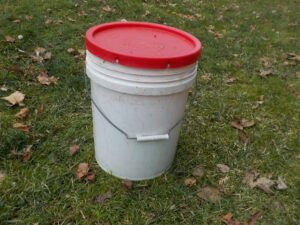
A 5-gallon pail will transport plenty of kitchen scraps to a local farm that can use them to make compost
High carbon materials include dead leaves, straw, tea bags, even a little shredded paper. If using newspaper, avoid glossy pages and things with lots of color. Newspapers are pretty benign these days, as they use soy inks and no heavy metals. I keep a supply of fall leaves next to my compost pile and spread a layer over the kitchen scraps every time I empty the compost bucket. That also minimizes flies in summer.
A good compost pile also needs oxygen to work well. And if your pile stays soggy, it won’t allow the microorganisms to get enough oxygen. But if your pile is too dry, the working microbes won’t be able to thrive, either. If you grab a handful and squeeze it, it should feel like a wrung-out sponge. People who really want a fast-acting compost pile turn over the compost with a garden fork regularly to help aerate it, but I don’t have the time or energy to do that.
In winter, most compost piles stop breaking down plant material because it is too cold for the organisms that cause decomposition. In summer, if yours is working well, temperatures can go up over 140 degrees F, which will kill weed seeds. In fact I‘ve done experiments and found that 125 degrees for a couple of days killed the seeds of the annual grass I placed in it – though some weeds may be tougher to kill than that. To get my compost pile that hot I layered in fresh lawn clippings. Still, the pile had cooler pockets and hotter ones.
So how does all this help you in winter? First, accept that your kitchen scraps will be frozen and not breaking down. Even those big plastic drums that rotate compost probably won’t work in winter – the material will be one big lump impossible to turn.
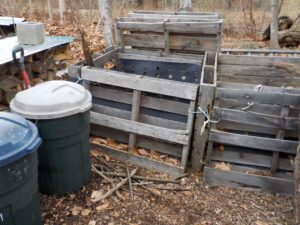
I keep chopped leaves in a barrel next to my compost pile to spread over kitchen scraps
I used to keep my compost pile near the vegetable garden so I could throw weeds in it. But the problem was that in winter I needed boots or snowshoes to get to my compost pile. If you don’t want to build a bin or trudge to a distant compost pile in winter, think about just using a big trashcan and saving all your scraps until spring when things thaw out and temperatures are good for composting. This will also keep dogs and skunks out of it. Recently I built a nice bin made of wood pallets that is next to my woodpile, near the house – and more accessible all year.
Not all compost is the same. The microbes attracted to material made from woody plants is different than that made from kitchen scraps and grass clippings. Think about the soil in an established forest: it is dark and rich, formed by the breakdown of leaves, twigs and branches over a long period of time. You can mimic that and speed up the process to create mulch or compost to put around newly planted trees and shrubs. Just compost you autumn leaves, twigs and small branches. I shred them in a chipper-shredder machine.
If you collect scraps (no meat or oil) and are a member of a CSA, they may accept your kitchen scraps for their composting system. If you have a 5-gallon pail with cover, you can easily transport it to a farm or recycling facility that accepts food scraps. When we were on vacation in Maine, we brought out kitchen scraps to a farm that used them for compost.
Aside from helping your plants, making compost helps keep food waste out of the landfill, which is important: we are running out of space in landfills. So do your part, even in winter. And whatever you make will enhance your soil when you add it in at planting time.
Henry is a UNH Master Gardener, the author of 4 gardening books and a lifetime organic gardener. Reach him at
henry.homeyer@comcast.net or PO Box 364, Cornish Flat, NH 03746.
Winter Mulching and Composting
Posted on Monday, December 20, 2021 · Leave a Comment
Although we had a little snow on the ground for much of November and December, snow has been scarce as we move towards the New Year. If this continues, does this have any consequences for our gardens? Yes, it can.
If we have bare ground and a very cold winter, roots will see colder temperatures than they might prefer. Like that pink fluffy fiberglass in the walls of our homes, snow is a great insulator. Snow holds tiny pockets of air, holding in warmth from the soil and preventing icy north winds from stealing warmth from the soil.
Lacking snow, what can one do? Fall leaves are great. If you have a leaf pile somewhere, think about moving some to spread around your most tender plants, especially things planted this year. Perennials and woody plants are most vulnerable to the cold their first winter.
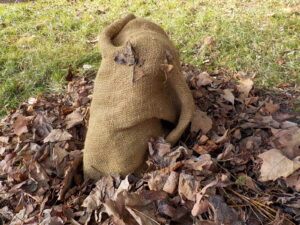
This tree peony is well protected from the cold with leaves and burlap
I have a tree peony that I planted this year, quite a pricey plant. Unlike the common perennial peony, the stems of the plant are woody and do not die back to the ground each winter. And the blossoms are much more dramatic: up to a foot across.
I have done two things for it: I mulched around the base with chopped leaves, and I wrapped some burlap around it to protect the stem itself and the flower buds that are already in place for next summer. This will help to keep January’s cold winds from affecting it. We have done the same for tender heirloom roses, with good success. Shrub jackets made of synthetic, breathable material are also available instead of making your own from burlap.
I worry about voles chewing through the burlap, nesting inside, and then eating the tender bark of my young tree peony. I had some ‘Bobex’ brand deer repellent and decided to spray the burlap. It is made with rotten eggs and other nasty stuff and might deter voles.
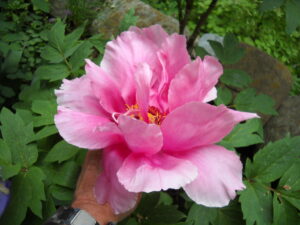
This tree peony had 10-inch wide blossoms
My wife, Cindy, and I recently used burlap to prevent hungry deer from eating the leaves and branches of a pair of large yews. First I drove four one-inch diameter hardwood stakes into the ground around each six-foot tall shrub. I stood on a step ladder and used a 3-pound short-handled sledge hammer to drive the stakes in about a foot. Then we draped the burlap over the top of the stakes and stapled the burlap to hold it in place on windy days. We used a heavy duty carpenter’s stapler as a desk stapler would not work. We have done this before, and the deer cannot get to one of their favorite winter meals. The wrapping we did was open to the top as deer can’t reach that high, but smaller plants should be completely wrapped.
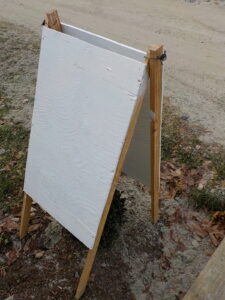
A simple A-frame protected this boxwood from the snowplow on our road last winter
Another hazard for plants is heavy snow and ice that fall off rooves, or is pushed up by snow plows. Last winter I made three A-frame plywood protectors for small shrubs to protect them. Each used four stakes and two pieces of plywood. At the top of each stake I drilled a hole and slid through both a piece of wire that connected the two stakes. This is a cheapskate’s way of avoiding the cost of hinges. And it works just fine! If the ground is not frozen, push the stakes into the soil, but if it is frozen, it should stand up fine anyway.
Later, after the holidays, recycle your evergreen tree in the garden. After I take off decorations, I use my pruners to cut off all the branches. This helps me find every last little ornament, and then I have a nice stack of evergreen branches to use around or over tender plants. The branches are good windbreaks for small shrubs, and hold snow through winter thaws as they sit over tender perennials. If you use a fake tree, watch for discarded trees waiting curbside, and snag one (or more) for use in the garden.

A simple A-frame protected this boxwood from the snowplow on our road last winter
Composting in winter is a chore that some gardeners don’t bother doing. But you should, as it is a waste to put your moldy broccoli in the landfill. For many gardeners the compost pile is a considerable distance from the house, requiring warm coats, gloves – and perhaps snowshoes. But there is an easy solution.
Invest in an extra garbage can, a large one that will hold 30 gallons or more. Place it inconspicuously but conveniently near the house. Ideally, you have a kitchen door behind the house, and can bring food scraps to it without bundling up for the cold.
Your winter compost will freeze, and will not break down during the cold months. So chop any big things to smaller pieces to allow it to pack down well. Then, come spring, you will have to shovel the material into a wheelbarrow and bring it down to your regular compost pile after it has thawed.
Of course, commercial compost bins are available to buy instead of the Mr. Thrifty 30-gallon plastic can. But since compost does not break down outside in winter, a plastic bin may not hold all the material you produce. If you fill the first one garbage can, an extra can is a smaller investment than a bin made just for compost. And those rotating bins? I’ve rarely met anyone who keeps turning them every week anyhow.
So get creative and protect your plants however you can. And if you have a great idea, write me so I can share it with others. My best to you all for the holidays!
Looking for a present to give? Henry is selling his book “Organic
Gardening (not just) in the Northeast: A Hands-On, Month-by-Month Guide”.
This is a collection of his best
articles. Send a check for $19 to Henry Homeyer at PO Box 364, Cornish Flat, NH 03746 or for faster service, use PayPal at
www.Gardening-Guy.com.








